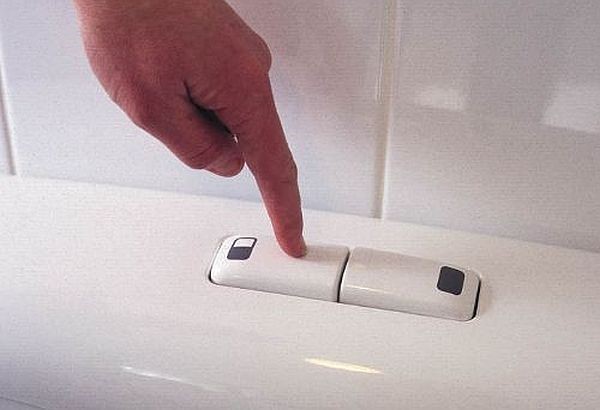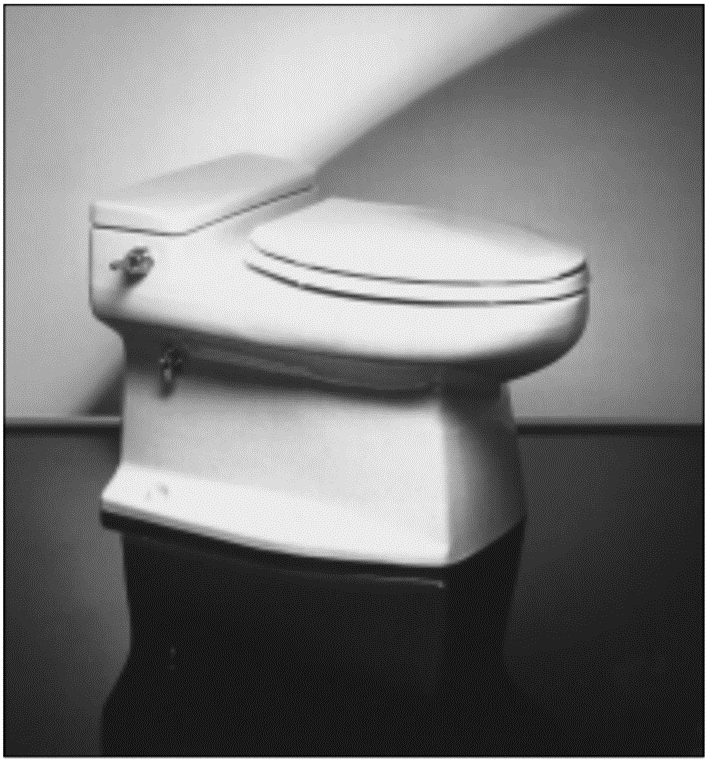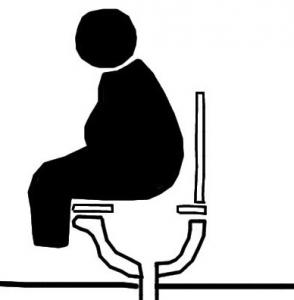Resumen ejecutivo
A low-flush or low-flow toilet is a flush toilet that is adapted in order to use significantly less water than a full-flush toilet. Low-flush toilets use a special design of the cistern and the siphon in order to allow the removal of faeces and excreta with less water. Most often, they also include a dual flush system, with one flush being designed for urine only, using even less water than the other designed for faeces. Today, there exist many suppliers of different models of low-flush toilets all over the world. Low-flush toilets reduce the water consumption, however, low-flush toilet still require large amounts of fresh water and with certain models, users have to flush even twice in order to achieve the complete removal of faeces from the bowl.
| Entradas | Salidas |
|---|---|
Freshwater, Urine or Yellowwater, Faeces, Excreta |
Blackwater |
Basic Design Principles
Low-flush toilets work with a very small amount of water. The exact amount of water varies between less than a litre (for urine only) up to 6 or 8 litres. These toilets can operate by gravity or vacuum. You can read more on vacuum toilets here. Gravity toilets have special requirements regarding the slope of the pipe. Large water savings are thus possible, which even facilitate the source separation of greywater and blackwater. If the gradient to the public sewer systems is steep enough, low-flush toilets can also be retrofitted into existing buildings. However, there is a risk of pipe clogging (HEEB et al. 2007).
In some cases, the volume of water used per flush is not sufficient to empty the bowl and consequently the user is forced to use two or more flushes to adequately clean the bowl, which negates the intended water saving (TILLEY 2014). Thus, many users were disappointed and frustrated with performance problems of the first generation of low-flush toilets. Since then, the manufacturers have solved these problems by modifying passageways to move a reduced amount of water more vigorously around the bowl. To make these toilets even more efficient, dual-low-flush toilets where developed. This type of toilet saves water by offering different flush volumes: a full-flush for solids (faeces) and a half-flush for liquids (urine) (JCSA n.y.).

Nowadays, products vary in that they may have narrower bowls with a smaller water surface, manually controlled water flow (via a foot pedal) into the bowl, or water pumps to assist in bowl emptying and cleaning. One model eliminates the “S” trap of a conventional toilet design, enabling waste to be washed down using less water. Another product flushes by opening a hinged flap to let wastes and a small amount of water fall into a lower chamber. After several seconds the flap reseals, and a blast of compressed air forces the wastewater over the trap and out a discharge line from the toilet (PIPELINE 2000).
Drain Lines
There are discussions about the performance of low-flush toilets to transport the waste trough the building drains to the public sewer system. As already mentioned, there is a risk of pipe clogging. Especially in older buildings, drain lines (slope, diameter, length) were designed for common flush toilets. More information and researches can be found in the document “Evaluation of Low-Flush-Volume Toilet Technologies to Carry Waste in Drain lines” (GAULEY and KOELLER 2005).

Reuse of Faecal Sludge as Fertiliser
The toilet waste or blackwater (urine and faecal matter) contains the majority of the nutrients in wastewater. A century ago, toilet waste was collected in major European cities and used as fertiliser in near urban agriculture. Ordinary flush toilets use much water and the blackwater becomes diluted. Modern toilet technology (vacuum or low-flush gravity) have flush volumes below 1 litre. With these toilets collection and separate treatment of the concentrated blackwater is more interesting in order to treat and reuse it (JENSSEN et al. 2004).
Costs Considerations
Costs are not higher than a common flush toilet system. But the huge savings of flush water and the smaller volume of generated blackwater reduce operation costs significantly.
Operation and Maintenance
Although flushing water rinses the bowl, the toilet should be scrubbed clean regularly. It is important that no other object than faeces or urine are tried to flush away, because in this case the risk of clogging is even higher and could lead to expensive cleanout costs.
Health Aspects
The low-flush toilet itself is safe and comfortable to use provided it is kept clean. There are no real problems with odours if used correctly (TILLEY et al. 2014). If the flush performance is bad, the bowl should be cleaned more often. Furthermore, in the absence of an appropriate (semi-)centralised treatment system, toilet wastewater flows through a sewer system directly into the environment without any treatment. This spreads pathogens and can endanger the health of residents.
At a Glance
| Working Principle | Human excreta is flushed away by a minimised amount of water. |
| Capacity/Adequacy | Basically, it can be built everywhere, urban and rural areas. A constant source of water and an appropriate sever system and (semi-)centralised treatment system must be available. |
| Performance | Depends on type, but there are many models with a high performance available. |
| Costs | Not higher than a common flush toilet system. Minimised flushed water and blackwater reducing operation costs. |
| Self-help Compatibility | Low, it might be difficult to find spare parts. |
| O&M | Easy to use and clean. Beside human excreta and toilet paper, no other objects should be flushed. |
| Reliability | If well maintained and constructed, high. |
| Main strength | Comfortable and hygienic for the user. Saves large amounts of water in comparison with common flush-toilets. |
| Main weakness | Still requires water. The risk of water pollution in sequence of unprofessional wastewater discharge is high. |
A flush toilet should not be considered unless all of the connections and hardware accessories are available locally. The low-flush toilet must be connected to both a constant source of water (can be a big problem and controversy in arid climates) for flushing and a collection and storage/treatment or conveyance technology to receive and treat the blackwater. The flush toilet is suitable for both public and private applications and can be used in every climate (TILLEY et al. 2014).
Sustainable Wastewater Management in Urban Areas
A document about sustainable wastewater management in urban areas.
JENSSEN, P.D. GREATOREX, J.M. WARNER, W. S. (2004): Sustainable Wastewater Management in Urban Areas. (= Kapitel 4. Kurs WH33, Konzeptionen dezentralisierter Abwasserreinigung und Stoffstrommanagement ). Hannover: University of HannoverM3: Ecosan Systems and Technology Components. M 3-2: Ecosan Technologies to Close the Water Loop
This presentation is adapted from the Ecosan Curriculum 2.2. The ecosan curriculum was created in order to compile the large amount of information on ecological sanitation in a structured and comprehensive way. This is a summary about the various Ecosan (or more: sustainable sanitation) systems.
HEEB, J. JENSSEN, P. GNANAKAN, K. CONRADIN, K. (2007): M3: Ecosan Systems and Technology Components. M 3-2: Ecosan Technologies to Close the Water Loop. Entradas: HEEB, J. ; JENSSEN, P. ; GNANAKAN ; CONRADIN, K. ; (2008): Ecosan Curriculum 2.3. Switzerland, India and Norway: .Evaluation of Low-Flush-Volume Toilet Technologies to Carry Waste in Drain lines. Final Report
This study researches if the minimised amount of water from low-flush toilets is able to carry waste in drain lines.
GAULEY, B. KOELLER, J. (2005): Evaluation of Low-Flush-Volume Toilet Technologies to Carry Waste in Drain lines. Final Report. Mississauga and Yorba Linda: Veritec Consulting and Koeller and Company URL [Visita: 13.05.2019]WaterSense High-Efficiency Toilet Guide
This guide mentions all important points if someone wants to buy a low-flush toilet.
JCSA (n.y): WaterSense High-Efficiency Toilet Guide. Williamsburg: James City Service Authority (JCSA). [Accessed: 14.03.2011] PDFAlternative Toilets Options for Conservation and Specific Site Conditions
This article describes some alternative toilet systems
PIPELINE (2000): Alternative Toilets Options for Conservation and Specific Site Conditions. Morgantown: National Small Flows Clearinghouse URL [Visita: 25.05.2011]Dual Flush Toilet Rebates
Compendium of Sanitation Systems and Technologies. 2nd Revised Edition
This compendium gives a systematic overview on different sanitation systems and technologies and describes a wide range of available low-cost sanitation technologies.
TILLEY, E., ULRICH L., LÜTHI, C., REYMOND P. and ZURBRÜGG C. (2014): Compendium of Sanitation Systems and Technologies. 2nd Revised Edition. Duebendorf, Switzerland: Swiss Federal Institute of Aquatic Science and Technology (Eawag) URL [Visita: 03.05.2023] PDFSick Water? The central role of wastewater management in sustainable development
This book not only identifies the threats to human and ecological health that water pollution has and highlights the consequences of inaction, but also presents opportunities, where appropriate policy and management responses over the short and longer term can trigger employment, support livelihoods, boost public and ecosystem health and contribute to more intelligent water management.
CORCORAN, E. ; NELLEMANN, C. ; BAKER, E. ; BOS, R. ; OSBORN, D. ; SAVELLI, H. (2010): Sick Water? The central role of wastewater management in sustainable development. A Rapid Response Assessment. United Nations Environment Programme (UNEP), UN-HABITAT, GRID-Arendal URL [Visita: 05.05.2010] PDFM3: Ecosan Systems and Technology Components. M 3-2: Ecosan Technologies to Close the Water Loop
This presentation is adapted from the Ecosan Curriculum 2.2. The ecosan curriculum was created in order to compile the large amount of information on ecological sanitation in a structured and comprehensive way. This is a summary about the various Ecosan (or more: sustainable sanitation) systems.
HEEB, J. JENSSEN, P. GNANAKAN, K. CONRADIN, K. (2007): M3: Ecosan Systems and Technology Components. M 3-2: Ecosan Technologies to Close the Water Loop. Entradas: HEEB, J. ; JENSSEN, P. ; GNANAKAN ; CONRADIN, K. ; (2008): Ecosan Curriculum 2.3. Switzerland, India and Norway: .Evaluation of Low-Flush-Volume Toilet Technologies to Carry Waste in Drain lines. Final Report
This study researches if the minimised amount of water from low-flush toilets is able to carry waste in drain lines.
GAULEY, B. KOELLER, J. (2005): Evaluation of Low-Flush-Volume Toilet Technologies to Carry Waste in Drain lines. Final Report. Mississauga and Yorba Linda: Veritec Consulting and Koeller and Company URL [Visita: 13.05.2019]WaterSense High-Efficiency Toilet Guide
This guide mentions all important points if someone wants to buy a low-flush toilet.
JCSA (n.y): WaterSense High-Efficiency Toilet Guide. Williamsburg: James City Service Authority (JCSA). [Accessed: 14.03.2011] PDFSustainable Wastewater Management in Urban Areas
A document about sustainable wastewater management in urban areas.
JENSSEN, P.D. GREATOREX, J.M. WARNER, W. S. (2004): Sustainable Wastewater Management in Urban Areas. (= Kapitel 4. Kurs WH33, Konzeptionen dezentralisierter Abwasserreinigung und Stoffstrommanagement ). Hannover: University of HannoverAlternative Toilets Options for Conservation and Specific Site Conditions
This article describes some alternative toilet systems
PIPELINE (2000): Alternative Toilets Options for Conservation and Specific Site Conditions. Morgantown: National Small Flows Clearinghouse URL [Visita: 25.05.2011]EcoFlush Urine Separating Toilet
This brochure introduces a urine separating low-flush toilet.
WOSTMAN (n.y): EcoFlush Urine Separating Toilet. Saltsjoe-Boo (Sweeden): Wostman Ecology AB URL [Visita: 13.05.2019]Guidelines for the safe use of wastewater excreta and greywater. Volume IV. Excreta and Greywater Use in Agriculture
Volume IV of the Guidelines for the Safe Use of Wastewater, Excreta and Greywater recognizes the reuse potential of wastewater and excreta (including urine) in agriculture and describes the present state of knowledge as regards potential health risks associated with the reuse as well as measures to manage these health risks following a multi-barrier approach.
WHO (2006): Guidelines for the safe use of wastewater excreta and greywater. Volume IV. Excreta and Greywater Use in Agriculture. Geneva: World Health Organisation (WHO) URL [Visita: 09.05.2019] PDFHow to Manage Public Toilets and Showers
The purpose of this decision-making aid is to provide practical advice and recommendations for managing toilet blocks situated in public places. It is primarily aimed at local decision-makers in developing countries and at their partners (project planners and managers).
TOUBKISS, J. (2010): How to Manage Public Toilets and Showers. (= Six Methodological Guides for a Water and Sanitation Services' Development Strategy , 5 ). Cotonou and Paris: Partenariat pour le Développement Municipal (PDM) and Programme Solidarité Eau (pS-Eau) URL [Visita: 19.10.2011]Case Study 4. Dual-Flush Toilet
This case study estimates the annual water consumption and savings that can be realised by a family of four using a dual-flush toilet instead of a conventional 13-litre or 6-litre toilet.
ATLANTIC ECOWORKS (n.y): Case Study 4. Dual-Flush Toilet. Charlottetown: Atlantic EcoWorks. [Accessed: 15.03.2011] PDFKohler Low-Flow Toilet: 2010 International Builders Show | Consumer Reports
This short video shows the performance of a low-flush toilet.
Toilets with FLUSHMATE® - How it works
The “How it Works” section of the company FLUSHMATE explains the flush system of its low-flush toilets.
A Better Toilet For A Cleaner World
The sanitation technology paradigm is under review, as past approaches are not sufficient or affordable to close the sanitation coverage gap. In 2011, the Bill & Melinda Gates Foundation (BMGF) launched the bold Reinvent the Toilet Challenge (RTTC) program to promote the development of radically new innovations to address the sanitation challenge on a large-scale. The RTTC is premised on the fact that ground-breaking improvements are required in toilet design and fecal sludge management to close the urban sanitation gap. The RTTC is focused on reinventing the flush toilet, a break-through public health invention that has not changed substantially since the first flush toilet patent was issued in 1775.

